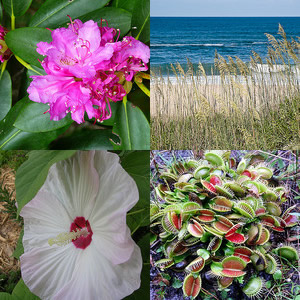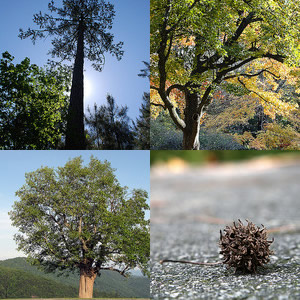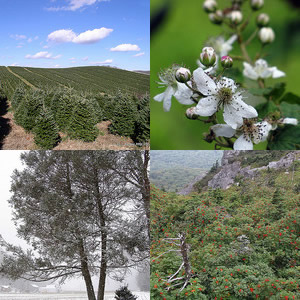Quick Introduction to North Carolina Plant Life
- North Carolina has over 4000 native plant species.
- North Carolina is home to 26 endangered plant species in the United States.
- North Carolina has over 700 rare plant species, and 162 of these are threatened or endangered in North Carolina.
A List of Endangered North Carolina Plants is available on the NC Department of Agriculture and Consumer Services website.
The wide variety of landforms found in the three regions of North Carolina is evident in the extreme range of vegetation throughout the state. Click on one of the three regions below to see a list of some of the most common plants found in each region.
Vegetation by region
Coastal Plain Piedmont Mountains
The Coastal Plain

Marshes and dunes are predominate vegetation types in the Outer Coastal Plain. Additionally, there are areas of preserved forests, which include: Nags Head Woods Preserve of the Nature Conservancy, Hatteras Woods in Buxton, and others scattered throughout Bougue Banks.
The Inner Coastal Plain is home to many swampforests and hardwood swampforests, a a feature which distinguishes it from the the Tidewater sub-region of the Coastal Plains.
Below is a list of several common plant species found throughout the Coastal Plains:
Asters
Beech
Black Gum
Blackjack Oak
Catbrier
Cypress
Dotted Horsemint
Dwarf Huckleberry
Gaillardia (aka Fire-Wheel, Indian Blanket)
Gallberry
Goldenrods
Hickory
Hophornbeam
Hypercium (aka St. John's Wart)
Laurel Oak
Lilies
Loblolly Pine
Loblolly Bay
Long Leaf Pine
Orchids
Palmetto (especially on Smith Island, aka Bald Head Island, and other southern islands)
Pine
Pine Hickory
Pitcher Plants
Pocosin (aka Bay, Shrub Bog)
Pond Pine
Post Oak
Purple Rhododendron
Red Cedar
Red Maple
Scrubby Post Oak
Sea Oats
Southern Red Oak
Sunflowers
Swamp Chestnut Oak
Swamp Mallow (aka Marshmallow, Swamp Rose)
Sweet Bay
Sweet Gum
Tulip Poplar
Turkey Oak
Variety of herbs
Venus Flytrap
Water Oak
Wax Myrtle
White Oak
Willow Oak
Wire Grass
Yaupon
Yellow Jessamine
Marshes: Bulrush, Cattail, Cordgrass, Needlerush, Saw Grass
Dunes: Beach Pea, Broomsedge, Croton, Dune Elder, Perennial Grasses, Primrose,; Spurge
Swamp Forests: Cypress Tree, Gum-Cypress Tree
Hardwood Swamp Forests: Ash, Cherrybark Oak, Elm, River Birch, Sweet Gum, Sycamore, Water Oak, Willow Oak
The Piedmont

Below is a list of several plant species found throughout the Piedmont:
Beech
Blackjack Oak
Carolina Shagbark Hickory
Chestnut Oak
Crabgrass (weed)
Hemlock (scattered)
Horseweed (weed)
Loblolly Pine
Northern Red Oak
Post Oak
Purple Rhododendron
Sand Hickory
Scarlet Oak
Several spring and summer flowering herbs
Shortleaf Pine
Southern Red Oak
Tulip Poplar
White Oak
White Pine
White Tipped Aster (weed)
Like the Inner Coastal Plain, the Piedmont has many hardwood swampforests, which are located in the floodplains. Some of the vegetation in the swampforests include:
Ash
Elm
River Birch
Swamp Chestnut Oak
Sweet Gum
Sycamore
Tulip Poplar
Willow Oak
The Mountain Region

The Mountains have two distinct areas of vegetation: the Deciduous Forests, which have more species of trees than all of Europe combined, and the Boreal Conifer Forests.
Below are lists of plant species predominately found in these forests in the Mountains:
Deciduous Forests:
Beech
Blackberry
Black Gum
Black Locust
Butternut Hickory
Chestnut Oak
Cucumber Tree
Dogwood
Few herbs sparsely scattered
Flame Azalea
Fraser Magnolia
Hemlock
Lack Oak
Mountain Laurel
Northern Red Oak
Red Maple
Rosebay Rhododendron
Scarlet Oak
Shortleaf Pine
Silverbell
Sourwood
Sugar Maple
Table Mountain Pine
Tulip Poplar
Virginia Pine
White Ash
White Basswood
White Oak
Yellow Birch
Yellow Buckeye
Boreal Conifer Forests:
Balsam
Beech Yellow Birch
Blueberry
Ferns and herbs present
Fir
Fire Cherry
Flame Azalea
Fraser Fir
Hawthorn
Mosses and Liverworts abundant
Mountain Ash
Mountain Laurel
Plott Balsam
Purple Rhododendron
Red Spruce
Rosebay Rhododendron
Shadblow
Spruce
Sugar Maple
Yellow Birch
Yellow Buckeye